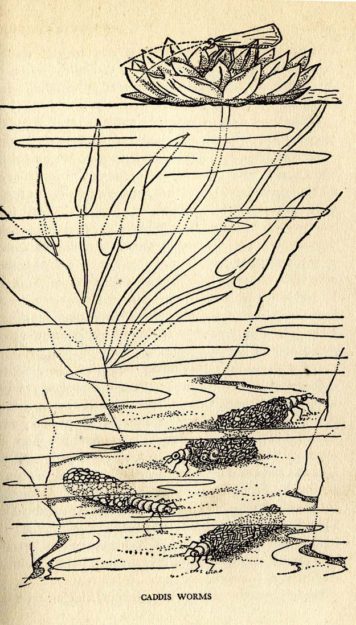Hilda T. Harpster, The insect world, Ill. Zhenya Gay, New-York, The Viking Press, 1947,
pp. 158-159.
 There is no accounting for the building tastes of caddis worms, for they use and old assortment of materials. In this respect however, they differ little from men. We use bricks and stones to build our houses; they use very tiny pebbles of all kinds and varieties. We select wood from the largest forest trees; they use pieces of wood, or sticks. Sand made into mortar gives us material for foundations; sand grains held together with a special type of cement secure the little insect against external dangers. In the tropics, natives build homes of bamboo and grasses, while beneath the waters of our near by ponds and lakes these insects are making their cases of leaves and bits of plants. The ways of Nature duplicate themselves among the very small and very large, among the very simple and the highly complex.
There is no accounting for the building tastes of caddis worms, for they use and old assortment of materials. In this respect however, they differ little from men. We use bricks and stones to build our houses; they use very tiny pebbles of all kinds and varieties. We select wood from the largest forest trees; they use pieces of wood, or sticks. Sand made into mortar gives us material for foundations; sand grains held together with a special type of cement secure the little insect against external dangers. In the tropics, natives build homes of bamboo and grasses, while beneath the waters of our near by ponds and lakes these insects are making their cases of leaves and bits of plants. The ways of Nature duplicate themselves among the very small and very large, among the very simple and the highly complex.
Although a great variety of materials is used by different species of caddis worms, one particular species always builds in the same manner. Certain species also select a particular type of environment. Building materials may fiffer, and water habitats may differ, but the larvae have one thing in common. They all use the same kind of insect cement to hold the parts of their homes together. This is a substance secreted by the larva and is called silk. The silk is formed in little glands opening into the mouth and is poured out in a gluelike sheet upon objects to be cemented together. Upon contact with water it hardens. Not only does this substance hold particles together, but it lines the little homes, making them firm and smooth.
The home of the caddis worm is generally a hollow cylinder with an opening at each end…./… The manner in which the caddis worm builds its home is very interesting. The larva that hatches from the egg, is of course, very small. Nevertheless, he must have a home. So he choses materials to his liking and cements these together with the gluelike silk. As time goes on and the larva becomes larger, a more spacious mansion must be furnished. The larva does not build a new house entirely, but adds on to the front, making the diameter larger. And he continues to add material ntil he is full grown and the case that lodges him is full sized. Being smaller at one end and increasingly larger toward the other, it takes on the shape of a cornucopia. However, in some instances, the larva tears down the back of his house and adds material to the front,, at the same time making the diameter larger. Then he has a home of the same width throughout.